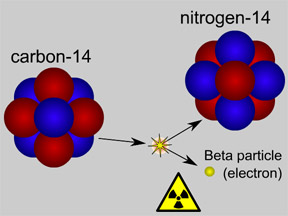Mercury's thin atmosphere contains hydrogen, helium, and oxygen. It also has smaller amounts of sodium, potassium, calcium, and magnesium. This picture shows sodium near Mercury. Red and green areas have the most sodium.
Click on image for full size
Image courtesy of NASA/Johns Hopkins University Applied Physics Laboratory/Carnegie Institution of Washington.
Atmosphere of Mercury
Mercury has almost no atmosphere. The planet's small size means that its gravity is too weak to hold down a normal atmosphere. There is a very thin atmosphere around the planet. Mercury's thin atmosphere is constantly being "blown away" into space by the pressure of sunlight and by the solar wind. Gases are constantly being added to Mercury's atmosphere, too. That's why it still has any atmosphere at all - even though that atmosphere is really, really thin.
Mercury's atmosphere contains small amounts of hydrogen, helium, oxygen, sodium, potassium, calcium, and magnesium. Some of the gas particles come from the solar wind. Others are made by radioactive decay or when micrometeorites smash into the surface. All of these gases are soon carried away from Mercury by the solar wind and by Mercury's magnetic field. Atmospheric pressure at the planet's surface is less than one trillionth of Earth's (around one nanopascal or 10-14 bar).
Temperatures at the surface range between 100 and 700 kelvins (-280° F to 800° F or -173° C to 427° C). Lead melts at 600 kelvins! This large range in surface temperature is possible because
Mercury is so close to the Sun (a year is only 88 Earth days long) and
does not have enough atmosphere present to moderate the range in surface
temperature.
You might also be interested in:

Some materials are radioactive. They give off radiation. When an atom of a radioactive substance gives off radiation, it becomes a new type of atom. This change is called radioactive decay. There are two
...more
Meteors are streaks of light, usually lasting just a few seconds, which people occasionally see in the night sky. They are sometimes called "shooting stars" or "falling stars", though they are not stars
...more
Mercury is the only inner planet other than the Earth that has a significant magnetic field (220 nT). This field, along with the planet's high density and small size relative to the Earth, indicates that
...more
Even though we can't see air, it is real and pushes on the things it surrounds. The push of the atmosphere is called pressure. Atmospheric pressure changes all the time. We can measure the pressure of
...more
The Kelvin scale is a temperature scale that is often used in astronomy and space science. You are probably more familiar with the Celsius (or Centigrade) scale, which is part of the metric system of measures,
...more
Do you know what MESSENGER stands for? It's the MErcury Surface Space ENvironment, GEochemistry Ranging mission! What does this mean? Well, the spacecraft will study Mercury's atmosphere, crust and polar
...more
Most planets are tilted. Their North and South Poles are not straight up and down. Earth is tilted a medium amount. Uranus is tilted a lot. Mercury is hardly tilted at all. It is tilted less than any other
...more















